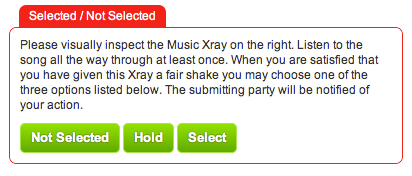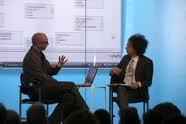Here at Music Xray, we’re all about transparency and about managing expectations. Sometimes people ask why they occasionally get the same response from different music industry professionals. So, we thought we’d take this opportunity to peek behind the curtain.
When an industry professional receives a song, they can hear the track, read any lyrics you’ve uploaded, read your bio, see your video (if you have one), check your Next Big Sound statistics, view the rest of your profile and songs on Music Xray (if they choose) and then, they are presented with three choices: Select, Hold, and Not Select.
Obviously, the more information you fill out in your song presentation profiles, the better impression you make with industry professionals. You should always include your lyrics, a photo or an image and even a video if you have one. You should always put your best foot forward.
Select: If your song is selected, you are alerted via email that your song has been selected and a pathway to communicate with the industry professional is opened. That allows you to begin a dialog and to close the deal. It’s important however to be respectful, patient, and courteous. You would be surprised to learn how many deals go south after a song has already been selected simply due to the industry professional deciding they’d rather not work with the artist. Remember, there are a lot of songs and artists out there, and while you should seek and expect a good deal, being “easy to work with” and “low maintenance” goes a long way.
Hold: This simply means the industry professional has put their decision on hold. You are free to continue to submit your song elsewhere. When your song is on hold, the industry professional will receive an email every 10 days reminding them they have your song on hold and that you are awaiting a final decision. Keep in mind that songs can remain on hold for a long time. This is especially true in television and film. It can take 18 months sometimes between when music supervisors begin looking for music and when the movie is done and final music selection begins.
Not Select: When an industry professional does not select a song, they are prompted with the screen you see in the image to the right. There, they can write their own reason for not selecting the song, or they can choose from one of the standard, but polite responses we provide. We provide these short answers because they are typical reasons songs are often not selected and part of what makes our system so appealing to industry professionals is that we make it so quick and easy.
We acknowledge that such a short response can sometimes be underwhelming to the submitter. It’s important to remember that before Music Xray, getting a guaranteed listen from an industry professional much less a response of any kind was unheard of. We will continue to make improvements where / as we can. In the meantime, if you’re seeking a longer and more detailed response to your song, we provide you a way to submit to industry professionals for song critiques and career coaching. When you submit to those drop boxes, you can expect much more detailed responses and perhaps even enter a dialog with the professional on the other side.
Once the industry professional has made their choice, we show them the next screen where they are asked to rate your song on each of five separate criteria. These ratings do not go directly back to you because we’ve found that industry professionals may sugar-coat their ratings if they know you will see them. Instead, we show you the average of the ratings once your song has been submitted to five separate opportunities and five professionals have rated your song.
That way, no industry professional is singled out for their rating and we feel an average of five ratings gives you an accurate reflection of how your track is being received by the industry. If you don’t like the ratings you’re receiving, you must face the fact that the ratings come from professionals you’ve selected. Presumabaly they are into your style and genre or you would not have submitted your music to them in the first place. It’s kind of hard to argue that the ratings aren’t an accurate reflection of how your music is perceived. If your ratings are good, keep submitting. If they are bad, consider getting some help from other industry professionals or consider submitting another track in the future.
Lastly, the ratings are used by the industry professionals themselves. They can log in to the “collective ratings” section of their account and see the ratings of all the other professionals and they can adjust the filters to suit what they are seeking. For example, they can adjust the filters to show them all the songs that have been reviewed and rated by at least 10 other industry professionals in the past month. They can also adjust the filters to show them only the songs that get high ratings on certain criteria. If hit potential isn’t important to a particular industry professional, they can adjust
the filter to disregard hit potential as a search criteria.
This feature enables the industry professionals to leverage each others’ filtering capability and expertise. Many of the deals that get done on Music Xray are a direct result of professionals finding the tracks they are seeking in this section, so for you, having multiple good ratings from five or more industry professionals can be the key to getting contacted when you least expect it. This is called “crowd-sourcing” and Music Xray is the only company to ever have successfully crowd-sourced the music industry. It’s pretty amazing when you think about it. Industry professionals visit this section of the site daily to scoop the cream off the top.
So, there you go… a peek behind the curtain at Music Xray. I hope this was interesting and helpful. If it was, please click the little Facebook “like” button below or the share options and help us spread the word.
Thanks,
Mike McCready
Co-founder & CEO
Music Xray


















